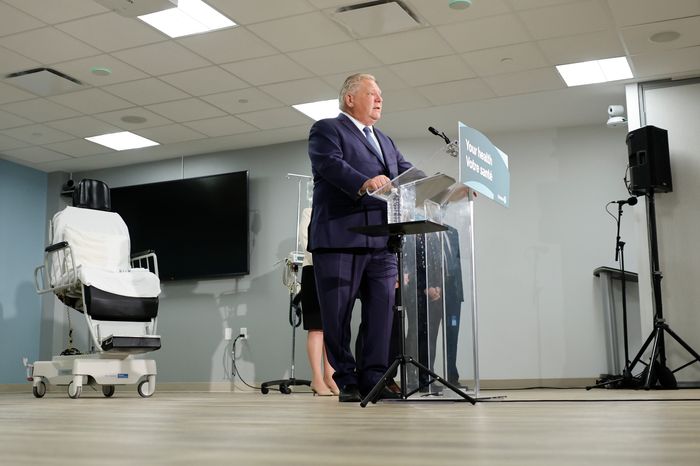TORONTO—Ontario is the latest Canadian province that is turning to private healthcare options in a bid to fix growing problems with the publicly funded healthcare system.
Canada’s most-populous province this past week outlined a plan to allow more patients to go to private treatment centers for cataract and joint-replacement surgeries as well as for services such as MRIs or CT scans. The province will invest more than 18 million Canadian dollars, equivalent to $13.4 million, in the private facilities to increase their capacity.
Ontario Premier
Doug Ford
said the moves would reduce the backlog of 206,000 surgeries in the province and free up public hospitals to concentrate on more-complicated procedures. Patients wouldn’t pay out of pocket, and the treatments would be covered by the provincial insurance plan, said Mr. Ford.

Ontario Premier Doug Ford said his plan to expand private healthcare options would reduce the backlog of surgeries.
Photo:
R.J. Johnston/Toronto Star/Getty Images
British Columbia, Alberta, Saskatchewan and Quebec have all in recent years increased the role of private clinics in their provinces.
Health authorities across Canada have been grappling with long wait times in emergency rooms, backlogs for surgeries and shortages of doctors and nurses.
According to the Fraser Institute, a public-policy think tank, the median wait time in Canada last year between referral and treatment was 27.4 weeks, the longest on record, compared with 9.3 weeks in 1993. Ontario reported the shortest wait time of 20.3 weeks, while the eastern province of Prince Edward Island reported the longest at 64.7 weeks.
Former government officials have been calling for a rethink of the way the Canadian system has been structured.
Bill Morneau,
former finance minister under Prime Minister
Justin Trudeau,
said in a memoir published this past week that Canada needed to change a system that costs the country an amount equal to roughly 13% of gross domestic product.
Peter Nicholson, who advised then-Prime Minister Paul Martin in the early 2000s, said in a policy paper earlier this month that Canada should look to countries such as Australia, Germany and Norway, which have used private healthcare to improve their systems.
Canada’s healthcare system is run separately by each province.

Nurses at a Toronto hospital during the height of Covid-19.
Photo:
cole burston/Agence France-Presse/Getty Images
In Ontario, healthcare unions have said Mr. Ford’s plan would enrich the private providers at the expense of the public hospitals and create a system in which wealthy residents get better services and treatment. Mr. Ford’s government has said that residents wouldn’t have to pay for procedures covered by the provincial insurance plan, but the private clinics would be able to sell patients more-expensive products not covered by the insurance.
Sharleen Stewart, president of SEIU Healthcare, which represents 60,000 Canadian healthcare workers, said the plan risks starving public hospitals of resources and siphoning doctors and nurses into private clinics, which could worsen outcomes for more-complex surgeries and deepen an already-acute healthcare labor shortage. “It will be a two-tiered system,” she said.
Job vacancies in healthcare and social services rose to a record high of about 150,100 in the third quarter of last year as demand for nurses surged, according to Statistics Canada. The Canadian healthcare system could be short 44,000 doctors by 2028, according to government projections.
Mr. Ford said his plan is meant to deal with the lingering impact of the Covid-19 pandemic, which caused delays for patients who needed treatment for nonpriority conditions or wanted to have tests done. Hospital wait times have surged since 2020. Patients in Ontario spent an average of 22.9 hours in an emergency department before being admitted to a hospital in October, the longest average wait time on record, according to provincial data.
There are roughly 900 private clinics in Ontario, most of which only do diagnostic testing; 10 private clinics are licensed to perform surgeries. More would open under the government’s plan.
During his announcement, Mr. Ford dismissed the concerns about how treatments are delivered. He said something must be done quickly to reduce the backlog of surgeries in the province. “A lot of people out there, they want to have the endless debates about who should provide care,” Mr. Ford said. “All our government cares about is that you get the care you need quickly and safely.”
Other supporters said that the plan could provide patients with more options, give them greater access to timely care and relieve stress on a system that has begun to buckle.
“We need to be more effective at deploying resources we currently have,” said
Allan O’Dette,
chief executive of the Ontario Medical Association, a group that represents 43,000 doctors and medical students and that supports Ontario’s plan. “Noncomplicated, low- acuity surgeries can easily be done outside a hospital setting.”
Write to Vipal Monga at vipal.monga@wsj.com
Copyright ©2022 Dow Jones & Company, Inc. All Rights Reserved. 87990cbe856818d5eddac44c7b1cdeb8










